 RELIGION RELIGION |
Buddhism is the dominant creed of the largest ethnic group, the Singhalese. More than 70% of the population belongs to this faith. It plays an extremely important role in the country both spiritually and culturally. Sri Lanka's literature, art and architecture are to a large extent a product of its Buddhist basis. About 15% of the populations, mainly Tamils, are Hindu. Muslims and Christians can both be of Sinhalese and Tamil ethnicity that converted.
However, there is much more mixing and melding among religious groups than these census figures would indicate. A Catholic, for example, might very well feel the need to pay his respects to the Hindu god Ganesh in order to ensure he has no obstacles or problems in his path in the course of a particular venture. Buddhist, Hindu, Muslim and Christian Sri Lankan's all venture to some pilgrimage sites, Adam's Peak and Kataragama in particular.
 Buddhism Buddhism |
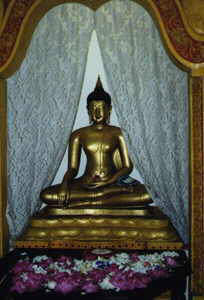
Strictly speaking, Buddhism is not a religion, since it is not centered on a god, but is rather a system of philosophy and a code of morality. It covers a wide range of interpretations of the basic beliefs that started with the enlightenment of the Buddha in north India around 2500 years ago. Siddhartha Gautama, born a prince, is said to be the fourth Buddha or 'Enlightened one', and is not expected to be the last. Since Buddhists believe achieving enlightenment is the goal of every being, eventually we will all reach Buddhahood.
The Buddha never wrote his teachings (dharma) down, and a schism later developed so that today there are two major schools of Buddhism. The Theravada or Hinayana, 'doctrine of the elders' or 'small vehicle', school holds that to achieve nirvana, the eventual aim of every Buddhist, you must 'work out your own salvation with diligence'. In contrast, the Mahayana, or 'large vehicle', school holds that its belief is enough eventually to encompass all humankind and bear it to salvation.
The Mahayana school has not rejected the Theravada teachings but claims that it has extended them; the Theravada school sees the Mahayana as a corruption of the Buddha's teachings. It is true that the Mahayana offers the 'soft option' - have faith and all will be well - while the Theravada is more austere and ascetic and harder to practice. In the Buddhist world today Theravada Buddhism is practiced in Sri Lanka, Thailand, Myanmar (Burma), Vietnam, Laos and Cambodia; Mahayana Buddhism is followed in Japan, Vietnam and among Chinese Buddhists. The Mahayana school coined the 'large' and 'small' vehicle terms. There are also other, sometimes more esoteric, divisions of Buddhism such as the Hindu-Tantric Buddhism of Tibet, also practiced in Nepal, or the Zen schools of Buddhism of Japan.
Buddha taught that life is suffering and that although there may be happiness in life this is mainly an illusion. To be born is to suffer, to live and toil is to suffer, to die is to suffer. The cycle of life is one of suffering, but humanity's suffering is caused by its ignorance, which makes it crave things to alleviate its pain. This is a mistake, for only by reaching a state of desiring nothing can one attain true happiness. To do this one must turn inward, master one's own mind and find the peace within.
This is an evolutionary process through many states of spiritual development until the ultimate goal is reached - death, no further rebirths, and entry to nirvana.
The Buddha taught that all things are part of the whole:
In the beginning is the One and only the One is. All things are One and have no life apart from it; the One is all things and incomplete without the least of them. Yet the parts are parts within the whole, not merged in it.
Supreme enlightenment is the only reality in a world of unreality, the teachings continue. All else is illusion and there is no unchanging soul that is reborn after life, but a consciousness that develops and evolves spiritually until it reaches the goal of nirvana or oneness with the all. Central to the doctrine of rebirth is karma, the law of causation; each rebirth results from the actions one has committed in the previous life. Thus in Buddhism each person alone is responsible for his or her life. The Buddha did not claim that his way was the only way, since in the end all beings will find a path because the goal is the same for all.
Ashoka, the great Indian emperor who was a devout Buddhist, sent missions to the entire known world, and his son Mahinda brought Buddhism to Sri Lanka. It took a strong hold on the country almost immediately and Sri Lanka has since been looked upon as a centre for Buddhist culture and teaching. It was in Sri Lanka that the Theravada school of Buddhism first developed and later passed on to other countries.
Buddhism emphasizes love, compassion and gentleness. This tolerant outlook has often resulted in its absorption into other religions (as eventually happened with Hinduism in India) or its absorption of already extant beliefs. On a personal level, the general experience one has of Buddhism remains largely the same from country to country despite local adaptations, changes, amalgamations and inclusions - it's an overriding impression of warmth and gentleness, a religion practiced by friendly people who are always eager to explain their beliefs. In Sri Lanka, however, Buddhism's institutionalization and politicization have given rise to one or two less agreeable aspects.
 Modern Sri Lankan Buddhism Modern Sri Lankan Buddhism |
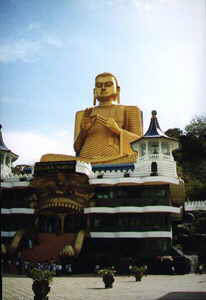
Since the late 19th century a strand of 'militant' Buddhism has developed in Sri Lanka, centered on the belief that the Buddha - who according to tradition visited Sri Lanka three times - charged the Sinhalese people with the task of making the island a citadel of Buddhism in its purest form. This more campaigning, less tolerant, Buddhism, perhaps taking its cue from the type of Christianity practiced by the British colonial power, emerged around the late 19th / early 20th centuries under the inspiration of Anagarika Dharmapala. It sees threats to Sinhalese Buddhist culture in both European Christianity and Tamil Hinduism.
Sri Lankan Buddhism has become increasingly intertwined with politics, to the point where the clergy can exert great pressure on politicians by accusing them of failing to look after Buddhism. Some Buddhist monks are among the country's least tolerant people when it comes to compromise with the Tamils. Nor are all monks anything like as pure, virtuous and unworldly as you might imagine! On the other hand, many monks are genuinely dedicated to the personal and spiritual side of Buddhism and many of the people still practice it in a simple, gentle way.
 Books on Buddhism Books on Buddhism |
A good book to start with is Christmas Humphrey's Buddhism (Pelican). There are many books on Buddhism available in Sri Lanka; a particularly good place to look is the Buddhist Publication Society in Kandy. The Buddhism Information Centre, opposite the Hilton Hotel in Lotus Rd, Fort, has a selection of books in English. There is a library of Buddhism at the Gangaramaya temple's Bhikku Training Centre, 61 Sri Jinarathana Rd, Colombo 2. For more information on places to practice and study meditation and Buddhism, see Kandy in the Hill Country chapter. |  Hinduism Hinduism |
Tamil kings and their followers from South India brought Hinduism initially to northern Sri Lanka. Today, there are significant Hindu communities in Colombo, Kandy and the tea plantation areas in the hill country, as well as in the north and east of the island.
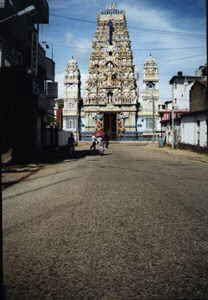
Hinduism defies attempts to define it in any specific sense. Some argue that it's more an association of religions. It has no founder, central authority or hierarchy. It's not a proselytizing religion. The orthodox view is that you can't be converted; to be a Hindu you must be born one. The strictly orthodox maintain that only a person born in India of Hindu parents can truly claim to be Hindu.
To outsiders, Hinduism often appears as a complex mix of contradictory beliefs and multiple gods. In theory it happily incorporates all forms of belief and worship. But for Hindus religious truth is ineffable; at its heart, Hinduism does not depend on the belief in the existence or otherwise of any individual or multiple gods.
Essentially, all Hindus believe in Brahman, the One without a second, without attributes. Brahman is eternal, uncreated and infinite; everything that exists emanates from Brahman and will ultimately return to it. The multitude of gods and goddesses are merely manifestations - knowable aspects of this formless phenomenon - and one may freely pick and choose among them.
Although beliefs and practices vary widely from region to region, there are several unifying factors. These include common beliefs in reincarnation, karma (conduct or action) and dharma (appropriate behavior for one's station in life), and in the caste system.
Hindus believe earthly life is cyclical; you are born again and again (a process known as samara), the quality of these rebirths being dependent upon your karma in previous lives. There is no escaping your behavior. Living a dharmic life and fulfilling your duty will enhance your chances of being born into a higher caste and better circumstances. Going the other way, rebirth may take animal form, but it's only as a human that you will gain sufficient self-knowledge to escape the cycle of reincarnation and achieve moksha (liberation). Traditionally, women are unable to attain moksha. The best they can do is fulfill their dharma and hope for a male incarnation next time round.
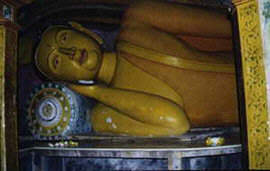
For ordinary Hindus, fulfilling one's ritual and social duties is the main aim of worldly life. The Bhagavad Gita (a Hindu text, part of the Mahabarata) is clear about this; doing your individuality. That the householder and the renunciate may equally earn religious merit is a notion that was enshrined some 2000 years ago in the Brahmanic ashrama system. This kind of merit is only available to the upper three castes.
 Islam Islam |
The Prophet Mohammed founded Islam in Arabia in the 7th century. The Arabic term Islam means to surrender and believers (Muslims) undertake to surrender to the will of Allah (God). The will of Allah is revealed in the scriptures (Koran; Arabic for reading or recitation) and it was Mohammed to whom God revealed his will, spurring him to act as his messenger.
Islam is monotheistic - God is unique and has no equal or partner. There is no concept of a trinity or Trimurti as encountered in Christianity and Hinduism. Everything is believed to be created by God and is deemed to have its own place and purpose in the universe. Only God is self-sufficient and unlimited. The purpose of all living things is submission to the divine will. Only humans have a choice: whether to obey or disobey. Humankind's weakness is its pride and sense of independence. Although God never speaks to humanity directly, his word is conveyed through messengers (prophets - who are never themselves divine; Mohammed is the most recent prophet) who are charged with calling humanity back to God.
In the years after Mohammed's death a succession dispute split the movement and the legacy today is the Sunnis and the Shi'ahs. The Sunnis, the majority, emphasize the 'well-trodden' path or the orthodox way. They look to tradition and the customs and views of the majority of the community. Shi'ahs believe that only imams (exemplary leaders) are able to reveal the hidden and true meaning of the Koran. The orthodox view is that there have been 12 imams, the last being Mohammed. However, since then mujtahids (divines) have interpreted law and doctrine under the guidance of the imam, and the imam will return at the end of time to spread truth and justice throughout the world.
All Muslims share a belief in the five pillars of Islam: the shahadah (declaration of faith) there is no God but Allah; Mohammed is his prophet' (this must be recited aloud at least once in a believer's lifetime, with conviction and true understanding); prayer (ideally five times a day and on one's own if one can't make it to a mosque); the zakat (tax), which today is usually a voluntary donation in the form of charity; fasting (during the month of Ramadan), undertaken by all except the sick, the very young, the elderly and those undertaking arduous journey; and the hajj (pilgrimage) to Mecca, something every Muslim aspires to do at least once.
Arab traders visiting Sri Lanka from the 08th century brought Islam to the island. Most Muslims here are Sunnis, although there is communities of Shi'ahs who have more recently migrated from the Indian subcontinent.
 Christianity Christianity |
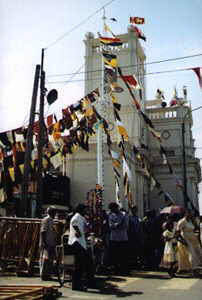
The Portuguese colonizers introduces Roman Catholicism to Sri Lanka in the 16th century and the Catholic Church remains strong among the western coastal communities - huge, imposing churches are prominent on the road north to Puttalam or south to Galle. The Dutch brought Protestantism and the Dutch Reformed Church, which has more of a presence in Colombo than elsewhere. Evidence of the British introduction of other denominations can particularly be seen in the hill country, where quaint stone churches dot the landscape. |

